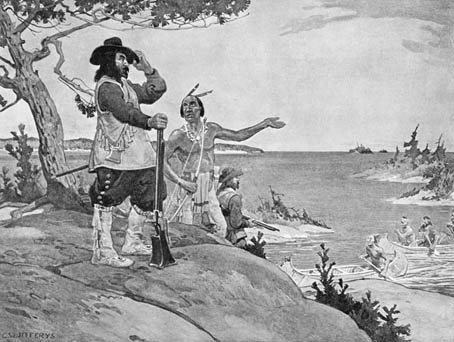
Four hundred years ago, in 1615, the European invasion of North America was in its infancy. Contact between the Indian nations and the Europeans was largely in the form of explorers, missionaries, and fur traders. The Europeans found that the Indian nations were diverse in their languages, cultures, and religions. Similarly, there were significant differences among the European nations with regard to their perception of the Indians and their land. In general, the French tended to view Indians as potential trading partners; the Spanish viewed Indians as a potential labor force; and the English often saw them as wild animals to be exterminated. While the Spanish debated about the moral and legal rights of the Indians, the English had no interest in Indian rights; Indian people were simply inconvenient occupants of land desired by the English.
The French, unlike the English and the Spanish, saw Indians as trading partners. The French saw that their best opportunity for economic gain was to be found in the fur trade in which their Native American trading partners would retain their autonomy and provide them with furs. The French explorers quickly established trading relations with the Native nations. From the beginning, the French were willing to learn from their Indian trading partners. Conrad Heidenreich, in his chapter on early French exploration in North American Exploration, writes: “The French obtained geographical information from natives, hired them as guides, traveled with natives, lived among them, and learned from them.”
The early French explorers sought to stake out French territorial claims in North America and to determine the nature of exploitable natural resources, such as furs and minerals.
Explorers:
In Ontario, French explorer Samuel de Champlain ignored Huron stories of Nipissing sorcery and visited one of the Nipissing villages. The Hurons discouraged contact with the Nipissing as they wanted to monopolize trade with the French.
Champlain then traveled to the Huron village near present-day La Fontaine. The village had triple palisades which are 35 feet high. The Huron warriors who were to accompany him were not there, so he journeyed on to the village of Cahiagué which had more than 200 longhouses.
The French party then visited Indians which they called Cheveux Relevées (High Hairs) because their hair was combed to stand very high. These were the Ottawa.
Champlain noted that the Iroquois-speaking people who lived near the western end of Lake Ontario were not involved with the conflicts between the Iroquois and the Huron. For this reason, the Europeans called this group Neutral. The Huron called them Atiouandaronk.
In Quebec, the French under Samuel de Champlain aided a joint Huron and Algonquin raiding party against the Iroquois. The joint war party attacked an Onondaga village. Conrad Heidenreich, in a chapter in the book North American Exploration, reports: “After attacking the village and laying siege to it for six days, the army withdrew to the Huron country the way they had come.”
While Champlain viewed the war as a total failure, it did result in a French-Huron alliance.
The French explorer Champlain crossed into New York with a party of Huron warriors. They captured three Iroquois men, four women, three boys, and a girl. Champlain complained when the Huron cut off one of the women’s fingers as a demonstration of the torture that lay ahead. Because of the French concerns, the Huron agreed not to torture the women.
The French-Huron party attacked an Iroquois fort near present-day Fenner, New York. After the initial attack, the Huron warriors withdrew. Champlain convinced the warriors to build large wooden shields for protection, and a large, moveable platform which overlooked the Iroquois palisades. While the plan had initial success the Huron warriors, unused to the discipline expected by European military leaders, broke ranks and attempted to set fire to the palisades. The Iroquois, however, simply poured water into the troughs which formed their fire defense system and the fires were quickly extinguished. Champlain was hit twice by arrows and was severely wounded. The Huron retreated carrying their wounded, including Champlain, in improvised baskets.
In New York, the Susquehannock sent 500 warriors to aid Samuel de Champlain in his war against the Iroquois. The warriors arrived two days after Champlain and his Huron allies had retreated. The Susquehannock warriors returned home without engaging in battle.
In Maryland, English explorers were welcomed with the sacred pipe. One of the Englishmen, Father Andrew D. White would later write of the ceremony: “each one smoking it breathes over the several members of his body and consecrates them.”
In Maryland, the colonial policy was to enter into formal treaties with the Indians. If the tribes placed themselves under the protection of the colonial government, they would receive guarantees for reserved lands as well as hunting and fishing rights. The tribes, however, also had to pay the colony an annual tribute, return any fugitive slaves and servants, and have their chiefs confirmed by the governor.
Etienne Brulé met a group of Erie near Niagara Falls, New York. This would be the only known encounter between this group and the Europeans. At this time, the Erie were in an alliance with the Neutrals and the Wenro against the Iroquois.
Missionaries:
In Quebec, four Récollet missionaries arrived to work among tribes operating trade networks with the Huron. For the most part, the missionaries stayed in Quebec and ministered the Montagnais. The Récollets are a reform branch of the Franciscans. With regard to their impact on the Indians, historian Matthew Dennis, in his book Cultivating a Landscape of Peace: Iroquois-European Encounters in Seventeenth-Century America, writes: “But the mendicant Recollets lacked the necessary resources, seemed ill-suited to this missionary work, and were too few to make a large impact.”
Books:
In Spain, Fray Juan de Torquemada wrote Monarchia Indiana in which he mentions the Pueblo fetishes as well as the Spanish names of the Pueblos. Archaeologist Adolph Bandelier, in his 1910 monograph Documentary History of the Rio Grande Pueblos of New Mexico, notes: “Torquemada himself was never in New Mexico, but he stood high in the Franciscan Order and had full access to the correspondence and to all other papers submitted from outside missions during his time.”
Indian Events:
In Maine, the Micmac captured and killed the Penobscot Sachem Bashaba, thus putting an end to the war which started in 1610. Following this victory, Micmac warriors raided down the coast of Maine and into Massachusetts.
In North Dakota, the Mandan established a village at the Larson site north of present-day Bismarck.
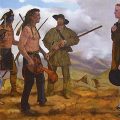
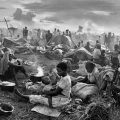
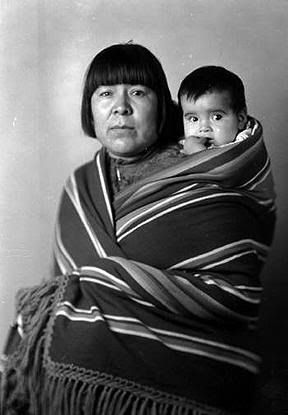
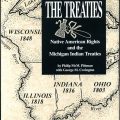
Leave a Reply